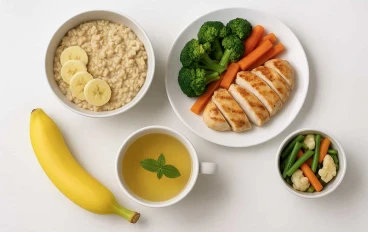
The Power of Plants: Unveiling the Best Sources of Plant-Based Protein
Introduction: The Rise of Plant-Powered Nutrition
In recent years, plant-based diets have surged in popularity, not just among vegetarians but also among those seeking a healthier lifestyle. This shift has brought attention to plant-based proteins as sustainable and healthful alternatives to animal proteins.
Chapter 1: Legumes - Nature’s Protein Powerhouses
Legumes, including beans, lentils, and chickpeas, are not only rich in protein but also fiber, vitamins, and minerals. They are versatile in cooking and can be the mainstay of any meal.
Chapter 2: Tofu and Tempeh - The Soybean’s Gift
Soy products like tofu and tempeh are complete proteins, containing all nine essential amino acids. They can be marinated, grilled, or stir-fried, making them a favorite in many cuisines.
Chapter 3: Nuts and Seeds - Small but Mighty
Nuts and seeds may be small, but they pack a nutritional punch. Almonds, chia seeds, and flaxseeds are excellent sources of protein and other vital nutrients.
Chapter 4: Whole Grains - More Than Just Fiber
Whole grains such as quinoa, buckwheat, and brown rice provide protein along with fiber and complex carbohydrates, offering sustained energy throughout the day.

Chapter 5: Green Warriors - The Protein in Your Greens
Green vegetables like spinach, kale, and broccoli contain more protein than one might expect, and they’re loaded with vitamins and antioxidants.
Chapter 6: Spirulina - The Blue-Green Algae Superfood
Spirulina is a microalgae that has gained fame as a superfood due to its high protein content and rich array of nutrients. It can be added to smoothies or taken as a supplement.
Chapter 7: Seitan - The Wheat-Meat Revolution
Seitan, made from wheat gluten, is known for its meaty texture and is a favorite protein substitute for many vegetarians and vegans. It’s versatile and can be used in a variety of dishes.
Chapter 8: Pea Protein - The Muscle Builder
Pea protein is emerging as a popular plant-based protein supplement, especially among athletes and bodybuilders, for its ability to aid in muscle growth and recovery.
Chapter 9: Hemp Hearts - The Heart-Healthy Protein
Hemp hearts are the seeds of the hemp plant and are full of protein, omega-3 fatty acids, and various minerals, making them great for cardiovascular health.
Chapter 10: Plant-Based Protein Powders - Convenience Meets Nutrition
For those on the go, plant-based protein powders offer a convenient way to ensure you’re getting enough protein. They can be derived from various sources, including rice, soy, and hemp.

Chapter 11: Edamame - The Young Soybean That Packs a Punch
Edamame are young soybeans often served in pods. They’re a fun, snackable source of protein that can also be added to salads and other dishes.
Chapter 12: Nutritional Yeast - The Flavorful Protein Boost
Nutritional yeast is a deactivated yeast that’s popular among vegans for its cheesy flavor. It’s a complete protein and can be sprinkled on almost anything for a nutritional boost.
Chapter 13: Mycoprotein - The Fungi-Based Protein
Mycoprotein is a protein derived from fungi, and it’s the primary ingredient in many meat substitute products. It’s high in protein and fiber, and low in fat.
Chapter 14: Ancient Grains - The Time-Tested Protein Sources
Ancient grains like amaranth, teff, and spelt have been cultivated for thousands of years and are excellent sources of protein, as well as other nutrients.
Chapter 15: Protein-Rich Vegetables - Beyond the Greens
Vegetables like potatoes, sweet potatoes, and Brussels sprouts also contribute a significant amount of protein to a plant-based diet.
Chapter 16: The Versatility of Chickpeas - From Hummus to Falafel
Chickpeas are not only a staple in Middle Eastern cuisine but also a versatile protein source that can be transformed into various dishes, from creamy hummus to crispy falafel.
Chapter 17: The Mighty Mung Bean - A Protein-Rich Sprout
Mung beans are often sprouted to enhance their nutrient profile, including their protein content. They’re commonly used in Asian cuisines and are perfect for salads and stir-fries.
Chapter 18: The Protein Punch of Pumpkin Seeds
Pumpkin seeds, or pepitas, are a tasty snack that’s rich in protein and other nutrients. They can be roasted and seasoned for a delicious treat or added to dishes for a crunchy texture.
Chapter 19: The Underestimated Protein in Root Vegetables
Root vegetables like carrots and beets are often overlooked for their protein content, but they provide a valuable addition to a balanced plant-based diet.

Chapter 20: The Surprising Protein Source: Mushrooms
Mushrooms are not only known for their umami flavor but also for their protein content, especially when dried. They’re a great meat substitute in many recipes.
Chapter 21: The Ancient Protein: Lupini Beans
Lupini beans have been eaten since Roman times and are making a comeback as a protein-rich snack and ingredient in Mediterranean dishes.
Chapter 22: The Protein-Rich Grain: Barley
Barley is a hearty grain that’s not only rich in fiber but also a good source of plant-based protein, making it a great addition to soups and stews.
Chapter 23: The Nutrient Powerhouse: Artichokes
Artichokes are a unique vegetable that’s not only rich in fiber and antioxidants but also contains a respectable amount of protein.
Chapter 24: The Protein in Pods: Green Peas
Green peas are often a side dish, but they’re also a good source of protein and can be the star of the show in dishes like pea soup or pea risotto.

Chapter 25: The Bean of Many Colors: Kidney Beans
Kidney beans are a colorful addition to any plate and provide a substantial amount of protein, especially when combined with whole grains.
Chapter 26: The Robust Protein of Black Beans
Black beans are not only a staple in Latin American cuisines but also a robust source of protein that can be used in a variety of dishes, from soups to burritos.
Chapter 27: The Protein Treasure in Wild Rice
Wild rice, with its rich, nutty flavor, offers a higher protein content than its white rice counterpart and serves as a nutritious addition to any meal.
Chapter 28: The Protein Gem: Pinto Beans
Pinto beans are a versatile bean that can be mashed, refried, or used whole in dishes, providing a hearty protein component to any meal.
Chapter 29: The Protein Power of Algae
Beyond spirulina, other algae like chlorella also offer significant amounts of protein and are becoming popular in the health food market.
Chapter 30: The Protein-Rich Bounties of the Sea: Seaweed
Seaweed is not only a staple in Asian diets but also a surprising source of protein, with varieties like nori and wakame being used in salads and sushi.

Chapter 31: The Hearty Protein of Lentils
Lentils are a protein-rich legume that comes in various colors and can be cooked into stews, salads, and even used as a meat substitute in patties.
Chapter 32: The Nutty Protein Source: Cashews
Cashews are a creamy and rich nut that provides protein and is often used in vegan recipes as a dairy substitute.
Chapter 33: The Protein Strength in Sunflower Seeds
Sunflower seeds are a crunchy snack that’s high in protein and can be added to salads, bread, or eaten on their own.
Chapter 34: The Protein in the Pod: Snow Peas
Snow peas are a crunchy and sweet addition to stir-fries and salads, offering a good amount of protein for their size.
Chapter 35: The Forgotten Protein: Collard Greens
Collard greens are a leafy vegetable that’s not only rich in vitamins but also contains a good amount of protein, making them a nutritious addition to any diet.




































